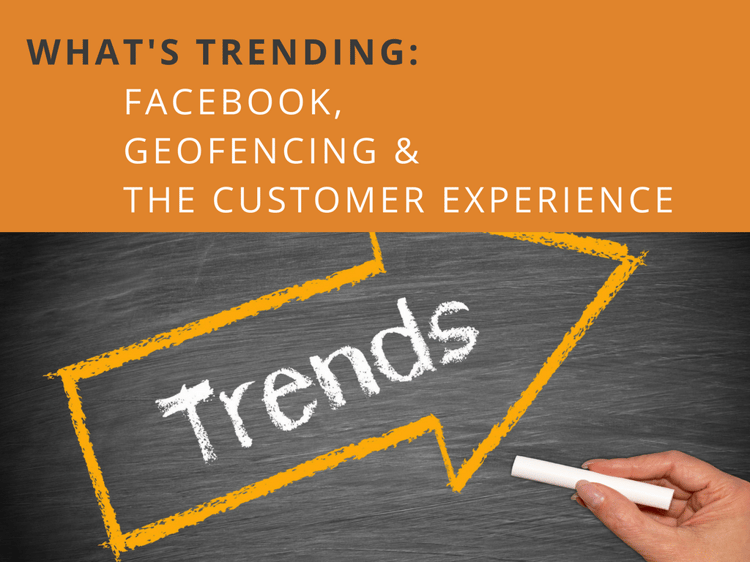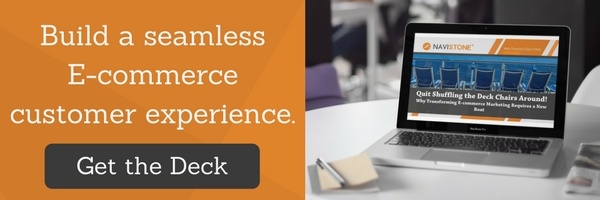This week's blog post is contributed by guest writer, Brook Mont. Brook is the Sales & Marketing Intern at NaviStone and a senior at the University of Cincinnati,...

If there’s one constant in the marketing landscape, it’s that marketing is always changing. New marketing technology sparks innovation in marketing practices and vice versa. Learning and getting to talk about all the cutting-edge marketing practices with industry experts and friends is a large part of what makes conferences and events like eTail West, ShopTalk, CRMC and NEMOA so much fun to attend.
With that in mind, here are five marketing topics we were excited to hear about and discuss at the various events we’ve been to over the last few months.
Refining and Expanding Audience Reach through Digital and Mobile
Facebook Lookalike Audience
Facebook’s data collection has set them apart from every other social media platform in existence. And although Facebook has reached a point of relative saturation, it continues to find ways to use data to its advantage. The company’s latest concept, Lookalike Audience, is exactly what you’d hope it would be based on its name. You can use your customer base to create a profile for your typical consumer, then upload the profile to Facebook. Facebook then uses your template to identify new prospects who match the characteristics of your current audience. This gives you a whole new set of consumers to reach — people who may not have seen your marketing yet, but are likely to be interested in what you have to offer. Another Lookalike Audience option is to upload an email file of your existing customers, allowing Facebook to find people with similar characteristics to your existing audience.
This game-changing technology is unique to Facebook at present time. And since Facebook has the most data and is pervasive among all demographic segments, it’s easily the best platform for this type of innovation. It’s highly beneficial for businesses, and it results in users seeing more relevant ads that might inspire them to take action.
Google AdWords Audience Targeting
Along similar lines, Google continues to expand its reach through its AdWords program. The company’s newest product enables companies to upload customer lists to Google and bid only on those consumers when they’re online. As a result, it’s easier for your company to deliver the right retargeting ad at the right time. The timely retargeting message might be all it takes to convert someone who’s been on the fence for a while, which could potentially result in a long-term reengagement with a customer.
Geofencing
The physical location of customers and prospects has become a component of marketing contact strategies. Whether you’re seeing a banner ad about a TJ Maxx store two miles away, or a notification about nearby KFC restaurants while using Waze for directions, marketers are beginning to realize the power of location-based marketing. However, most businesses are just beginning to scratch the surface regarding what’s possible in terms of using location to their advantage.
Geofencing is the next step forward in location-based marketing. Instead of simply targeting everyone in a given area, geofencing combines audience interests with location-based marketing, two concepts that should be part of every marketing campaign. For example, if your company sells car parts, someone who attends a classic car show has a clear interest in your offerings. You can use geofencing to “fence” an area around a local car show, offer free wi-fi to people in attendance and then market to those people with digital ads and offers regarding the types of products and services you sell. Best of all, you’re able to tie locality and genuine interest to a particular individual.
Machine Learning
It’s no secret that our devices are doing a better job keeping up with us these days. Part of the reason is because they’re simply better devices with more technological capabilities. The other factor is that our devices have enhanced their ability to learn from us. We’ve talked about machine learning in our 2 Guys and Some Data podcast and how it will affect direct to consumer marketing over the next five years.
The most obvious application of machine learning occurs when you conduct a Google search, or even when you type in the text window of your Chrome browser. Google’s ability to predict what you’re looking for is a result of your prior activities, which Google has analyzed to determine what you might want to see in the future. Every search result and every action taken is charted. This allows the machine to measure it’s predicted outcome against the user outcome. The machine can then update its algorithms to include what it learned from each action. The algorithm is constantly being updated and refined based on how users act, which is pretty amazing. It’s easy to see that machines are quite capable of thinking along the same lines as humans; in some cases, technology even knows what we want before we do.
How does this relate to marketing? One of the biggest potential areas for machine learning is in the direct mail industry, where millions of letters and postcards are sent each year, and there’s a data trail behind each letter and each recipient. The potential for technology to learn what people like and tailor individualized direct mail pieces to consumers is very high. Additionally, machine learning can even be used to find the right price points for a particular product.
Advanced Digital Printing Capabilities
The increase in data-driven marketing in recent years has transformed digital marketing. Just as data has been the driving force behind digital marketing’s emergence, the move towards data-driven marketing has benefited offline marketing. Tools like programmatic postcards use the science behind digital retargeting, but move the conversation into a tangible and response-friendly format. Postcards are just one application of this combination of digital insights and offline reach.
Modern technology allows businesses to print custom catalogs for each individual customer based on what each person likes and what they’re most likely to respond to. Kroger, a supermarket chain, now prints custom flyers based on a household’s purchases, which they can track through their store’s loyalty card. From a pool of a few thousand products, Kroger creates a unique flyer featuring a few hundred items a specific household is most likely to be interested in. The applications for this technology are virtually limitless, and the future of print marketing is incredibly bright.
Changing the In-Store Experience
The merging of digital marketing with offline marketing techniques goes beyond print advertising. The in-store customer experience is also changing as a direct result of online interactions between consumers and their favorite brands. Smart companies will continue to evolve the customer experience, creating a truly personal relationship that encourages and nurtures consumers throughout the path to purchase.
We’ve seen some applications of digital marketing manifest themselves in stores. For instance, QR codes that enable consumers to learn more about a given product at their leisure, or photo-friendly displays that lend themselves to social media exposure. But these tricks merely hint at what’s to come.
One of the strongest enhancements to the in-store customer experience can be seen at Nordstrom, a retail chain that’s famous for its customer service and personal shoppers. Nordstrom is taking this approach to the next level in the digital age. Now, customers can go online and identify items they might like to purchase. Once the clothing articles and sizes have been selected, shoppers can head to their local Nordstrom, where the items have been pulled and are waiting for the customer to try on. Not only does this save time for both the customer and Nordstrom staff, but it has the potential to change the way people shop at Nordstrom — and at clothing retailers in general.
The pressure is on for retailers to try something different. People don’t want to shop anymore. The traditional “shopping experience” is evolving into a “research and test” experience. Consumers want something that goes above and beyond looking for what they need or want. They want to know that what they purchase is going to be the best choice for them, and the best way to learn that is to use or try the product. This has been true in digital sphere for some time with free 30-day trials to software and apps, but it’s becoming increasingly important at brick-and-mortar stores as well.
Staying on Top of Marketing Technology, Tools and Trends
Any experienced marketer knows the real key to marketing is staying aware of emerging trends. Some trends catch on while others fizzle out before they even get started. But taking part in and listening to these intriguing marketing conversations about the technology, tools and trends that are emerging will increase your business’s ability to beat your competition to the punch, providing a stellar customer experience with the ability to reach consumers of all types.

